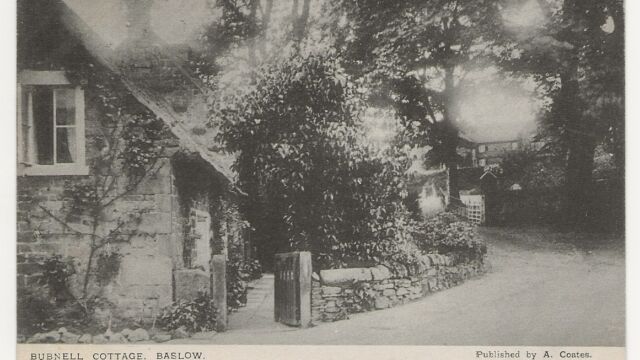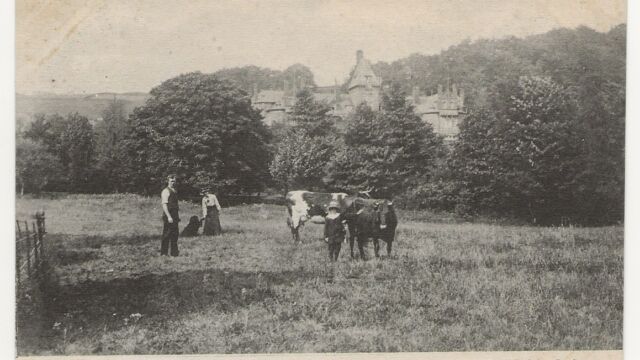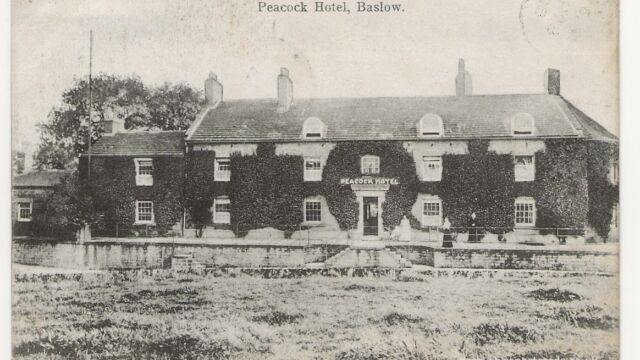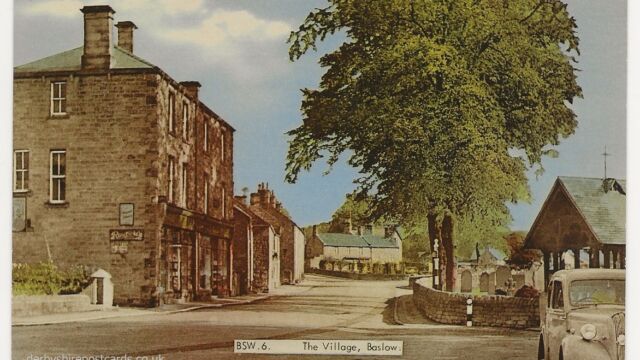BASLOW
Baslow village is the largest of the Derwent villages downstream of Hathersage but still within the boundary of the Peak Park.
Although relatively small, is made up of three main areas:
Bridge End (by the river crossings) is the original settlement clustered around the church and the ancient bridge and ford across the River Derwent.
Nether End (adjacent to Chatsworth Park) is at the eastern end of the village and modern centre of the village.
Over End (north of the main road) is a residential area on the hillside to the north of the village. It contains Baslow Hall, just off Calver Road, which was once occupied by Sebastian Ziani de Ferranti, the radio and electrical pioneer and inventor and then by George Kenning. Near the junction of Bar Road and Gorse Bank Lane was the site of a large Hydropathic hotel, which was demolished in 1936 and is now a small cul-de-sac called Hydro Close.
Bubnell Hall
Bubnell Hall is described as a superb Grade II listed built of sandstone under a stone slate room and dates back to the mid 17th century. The property has been added to over the centuries and now represents one of the most important houses in the area.
from History, gazetteer and directory of Derbyshire by Samuel Bagshaw (of Sheffield.) 1846 p424
Bubnell Hall, formerly a seat of the Bassetts of Blore, and afterwards, by marriage, of Copwood, forms a good specimen of the architecture of the early part of the 17th century, and has a good view of the Derwent. It is now a farmhouse, and Mr Jepson Oddy, the occupier, has respectable apartments for families wishing to be located for a time in the district.
Grand Hotel (from Derbyshire Heritage)
Baslow Hydro was set of meticulously landscaped grounds in twelve acres on a raised plateau at the foot of Yeld Wood, where it dominated the right side of Tithebarn Lane, later renamed Eaton Hill. Present day Hydro Close was in the grounds. Unlike the mineral rich waters at Matlock and Buxton, the Baslow springs were peaty and organic.
Mr. Henry Pawson, a prominent Sheffield businessman founded the Eagle Tor Hydropathic Establishment with the assistance of the Duke of Rutland and Architect S. L. Swann. A sum of £20,000 was raised by selling 2000 shares in the new venture at £10 each.
On July 21, 1880, the foundation stone was laid by Edward Tozer, Chief Magistrate and Mayor of Sheffield in an elaborate ceremony attended by the Master Cutler, Alderman D. Ward, Chairman of the Directors, Mr. R.WM. Nesfield, the Duke’s agent, and a crowd of locals. It took approximately one year to construct.
On the ground floor were verandas on both sides of an impressive porch, privileged guests would find a large dining room at one end of the long corridor and a drawing room of similar dimensions at the other. Behind private sitting-rooms to the rear were two matching glass-roofed wings, each 58 feet long by thirty feet wide: one a ballroom, the other dedicated to billiards.
Higher floors contained accommodation for 150 people, separate stairways leading to Ladies’ and Gentlemens’ washrooms : the latter furnished with a large plunge-bath.
A basement contained the manager’s room, a kitchen, scullery, and servant quarters.
Outside, there was a fountain, waterfall, croquet lawn, bowling-green, small pond, boating-lake around an island, orchard – and a one and a half acre vegetable garden. Alternatively, guests had use of a nine-hole golf course, summerhouses and two double tennis-courts: tennis then being at the height of its popularity. The golf course was a 9 hole course laid out in the hotel’s grounds, Club membership was 35. Visitors to the hotel paid 1/-a day and 5/- a week, others paid 1/6 a day, 7/6 a week
The Hydro owed its fame and fortune to an Edwardian-Victorian preoccupation with “healing” waters, spas and hydropathic treatments. Indeed, Smedley’s Hydro in nearby Matlock was one of the largest and best appointed in the whole of England – and the town of Matlock, at one time, hosted more than twenty other hydros.
Baslow’s Hydro remained profitable right up until the outbreak of World War 1, although it was not able to offer the fullest range of cures for gout, colic, apoplexy, dyspepsia, flatulence, indigestion and melancholia, because it lacked all the German, Russian or Turkish baths. A further twenty bedrooms were added, in a long wooden annexe, during the 1890s.
In 1899, Baslow Grand Hotel and Hydro’s application for a full drinks’ licence was rejected on the grounds that the village already had six licensed beerhouses. Thus residents could only drink wine and beer in the hotel or visit one of the local pubs if spirits were required.
After many profitable years the business went into decline. As travel became easier and more civilised the way was open to visit many other Hydros at home and abroad.
Added to that the Depression reduced the number of potential customers.
Baslow Hydro closed in 1930 leaving just Miss Gill the spindly caretaker.
Despite many rumours about a potential London buyer it was eventually sold for demolition with fixtures and fitting being auctioned off.
Contents of rooms were sold off with bedroom suites being sold for a pound, richly-upholstered armchairs for fifteen shillings; along with carpets, brass fireplaces and marble wash-stands.
Mr. White of Darley Dale paid £3000 for demolition rights. Demolition was completed in 1936.
A few remnants of Baslow Hydro still exist. There is a pair of gate-posts at the end of a bungalow drive on the crest of Eaton Hill. The fountain of Fountain House is also a relic of the Hotel and Moor Edge Bed and Breakfast Guest House is built from recovered stone. both are located in the former Hydro grounds at Hydro Close.
Peacock Inn (from http://www.cavendish-hotel.net/)
1700s – there has been an Inn here for so long it is uncertain when it was built. Originally the famous Peacock Inn, it was the property of the Duke of Rutland and served the turnpike between industrial Chesterfield and the spa town of Buxton.
1830 – It became the Duke of Devonshire’s property around 1830 and in the early 1970’s was rebuilt as the Cavendish by Chatsworth Estate when the original character was preserved and the Duchess of Devonshire selected the decor and furnishings, some of which came from Chatsworth House itself.
1975 – 2008 – The Cavendish Hotel operated between 1975 and 2008 under the proprietorship of Eric Marsh.
2008 – In September of 2008, Eric’s lease for the tenancy of the Cavendish came to an end. However,along with three other colleagues he negotiated a Management Contract to operate the Cavendish on behalf of the owners, Chatsworth Settlement Trustees.
Baslow Church (from Derbyshire Heritage)
Baslow church tower has two clocks, on the north side is a ‘normal’ one ,dated 1759, with conventional numerals but the east face clock is totally unique.
In place of numerals this clock face has 12 letters and numerals which spell out – VICTORIA1897
This was the gift of Dr Wrench to commemorate Queen Victoria’s Diamond Jubilee.
Lt. Col. Edward Mason Wrench served in the Crimea with the 12th Lancers in the Indian mutiny. He took over a medical practice in Baslow in 1862 and also had medical responsibilities at Baslow Hydro and Darley Dale. He was made a Member of the Royal Victorian Order by King Edward VII. there is a memorial to Dr Wrench in Baslow churchyard.
On Baslow chucrch door is a sanctuary knocker – fugitives from justice would take hold of this and beg for entry into the church around the Middle Ages, they would then be safe from capture for as long as they stayed within the sanctuary of the church and the church bell would have been rung to warn the people of Baslow that the fugitive was within.
A glass case in Baslow church porch holds a dog whip. It was the dog whipper’s duty was to chase stray dogs from the church, keep animals in church in order and to prevent anyone in the congregation from dozing off.
In the 17th and 18th centuries it was common practice to employ a dog whipper. An annual wage was often paid – at Youlgrave the parish accounts show that in 1604 the dog whipper was paid 1s 4d (7p) annually and by 1716 this had not increased. At Castleton in 1722 the ‘sluggard waker’ was paid ten shillings and used a long wand to tap anyone on the shoulder who looked like dozing off.
The Baslow whip has a leather bound handle with a three foot thong.











